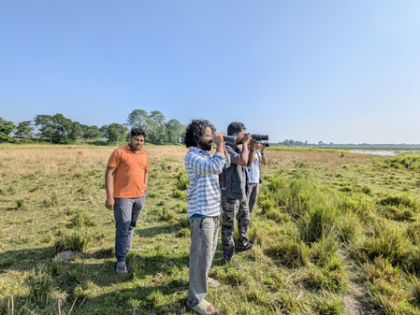Assam’s Kaziranga records 146 bird species in latest survey
By IANS | Updated: October 19, 2025 15:40 IST2025-10-19T15:36:46+5:302025-10-19T15:40:38+5:30
Guwahati, Oct 19 Kaziranga National Park and Tiger Reserve (KNPTR), India's seventh UNESCO world heritage site, recorded a ...

Assam’s Kaziranga records 146 bird species in latest survey
Guwahati, Oct 19 Kaziranga National Park and Tiger Reserve (KNPTR), India's seventh UNESCO world heritage site, recorded a total of 146 bird species and 1,919 individual birds in its latest bird survey, officials said on Sunday.
A senior official said that the ‘Kati Bihu Bird Count 2025’ was successfully organised at Kaziranga on Saturday by the Assam Bird Monitoring Network (ABMN) in collaboration with the KNPTR authorities.
The KNPTR official said that the bird surveys were conducted across five key locations -- Panbari Range, Laokhowa Wildlife Sanctuary, Panpur, Gamiri Range (both under the Biswanath Wildlife Division), and Agoratoli Range.
The collective survey recorded a total of 146 bird species and 1,919 individual birds, with Agoratoli showing the highest diversity at 89 species, followed by Gamiri and Panbari (59 species each), Panpur (55 species), and Laokhowa (37 species).
Among the recorded species, two were endangered (Swamp Grass Babbler and Pallas’s Fish Eagle), six were vulnerable (River Tern, Greater Spotted Eagle, Slender-billed Babbler, Lesser Adjutant, Great Hornbill, and Swamp Francolin), six were near threatened (Woolly-necked Stork, Northern Lapwing, Blossom-headed Parakeet, Grey-headed Fish Eagle, Spot-billed Pelican, and River Lapwing), while 132 species were of least concern.
According to the official, the survey documented several important resident and migratory birds, including Blue-eared Barbet, Bluethroat, Grey-headed Lapwing, Grey-headed Woodpecker, Greater Racket-tailed Drongo, and Indian Spot-billed Duck.
It also recorded Jerdon’s Baza, Ruby-cheeked Sunbird, Swamp Francolin, Taiga Flycatcher, Chestnut-capped Babbler, Greater Spotted Eagle, and Blue-naped Pitta.
The official said that the Kati Bihu Bird Count 2025 served as a significant citizen science initiative, promoting inclusive, community-based conservation. He added that the active participation of students, youth, birders, and especially women forest staff demonstrated a growing commitment to wildlife conservation in Assam.
The findings will contribute to long-term monitoring of bird populations and enhance understanding of habitat health in the Kaziranga landscape, the official noted.
The ABMN extended its sincere appreciation to all participants, coordinators, and the KNPTR authority for their support. It also expressed heartfelt gratitude to Kaziranga National Park Director Sonali Ghosh for her encouragement and unwavering support, which was instrumental in making the Kati Bihu Bird Count 2025 a success.
A total of 63 participants, including bird enthusiasts, students, researchers, and forest officials, took part in the count.
The event aimed to promote bird monitoring, raise conservation awareness, and encourage participation among local communities with a special focus on engaging women forest staff and the younger generation.
The Bihu festivals of Assam are three major celebrations connected to the agricultural cycle. Rongali or Bohag Bihu in April (marking the Assamese New Year and spring), Kongali or Kati Bihu in October (a solemn occasion for seeking a good harvest), and Bhogali or Magh Bihu in January (a harvest festival marked by community feasts). All three are celebrated with unique traditions such as the Bihu dance, traditional music, and festive delicacies.
Disclaimer: This post has been auto-published from an agency feed without any modifications to the text and has not been reviewed by an editor
Open in app